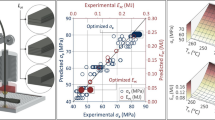Abstract
Among many machining operations, drilling has become one of the important machining operations performed in polymer composites. The quality of the drilled hole is closely associated with the drilling parameters and conditions. The current work focuses on the optimization of multiple response characteristics during drilling of hybrid glass fiber reinforced polymeric nanocomposites. Taguchi’s L25, orthogonal array is used to conduct the experiments and for optimization of the process parameters. The machining parameters such as spindle speed, feed rate, and drill diameter are optimized for the response which includes delamination, thrust force and torque via grey relational analysis technique. From the grey relational grade analysis, it is clear that the drill diameter is the most influencing factor followed by the feed rate and the spindle speed. The optimized process parameter settings were found as spindle speed of 2700 rpm, the feed rate of 30 mm/min and drill diameter of 4 mm, respectively, for lower delamination, torque and thrust force. Among the various modeling techniques used, ANN is found to be suitable for the process with minimum error percentage of 0.526.


















Similar content being viewed by others
Abbreviations
- Ni–P/GF:
-
Nickel Phosphorus coated glass fiber
- Al2O3 :
-
Aluminum oxide
- GFRP:
-
Glass fiber reinforced plastic
References
Rahman M, Ramakrishnan S, Prakash JRS, Tan DCG (1999) Machinability study of carbon fiber reinforced composite. Mater Process Technol 89–90:292–297
Lubin G (1982) Handbook of composites. Van Nostrand Reinhold, New York
Palanikumar K, Prakash S, Shanmugam K (2008) Evaluation of delamination in drilling GFRP composites. Mater Manuf Process 23(8):858–864
Arul S, Vijayaraghavan L, Malhotra SK, Krishnamurthy R (2006) The effect of vibratory drilling on hole quality in polymeric composites. Mach Tools Manuf 46:250–259
Liu DF, Tang YJ, Cong WL (2012) A review of mechanical drilling for composite laminates. Compos Struct 94:1265–1279
Lazar MB, Xirouchakis P (2011) Experimental analysis of drilling fiber reinforced composites. Mach Tools Manuf 51:937–946
Zitoune R, Collombet F (2007) Numerical prediction of the thrust force responsible of delamination during the drilling of the long-fibre composite structures. Compos Part A 38:858–866
Mohan NS, Ramachandra A, Kulkarni SM (2005) Influence of process parameters on cutting force and torque during drilling of glass- fiber polyester reinforced composites. Compos Struct 71:407–413
Khashaba UA (2004) Delamination in the drilling GFR-thermoset composites. Compos Struct 63:313–332
Palanikumar K, Prakash S, Shanmugam K (2008) Evaluation of delamination in drilling GFRP composite. Mater Manuf Process 8:858–864
Davim JP, Reis P (2003) Study on the delamination in drilling carbon fiber reinforced plastic using design of experiments. Compos Struct 59:481–487
PalaniKumar K, Latha B, Senthilkumar VS, Davim P (2012) Analysis on drilling of glass fiber–reinforced polymer (GFRP) composite using grey relational analysis. Mater Manuf Process 27:297–305
Tosun N (2006) Determination of optimum parameters for multi performance characteristics in drilling by using grey relational analysis. Int J Adv Manuf Technol 28:450–455
Kuo Y, Yang T, Huang GW (2008) The use of a grey based Taguchi method for optimizing multi-response stimulation problems. Eng Optim 23(1):51–58
Zadeh LA (1965) Fuzzy sets. Inf Control 8(3):338–353
Palanikumar K (2009) Surface roughness model for machining glass fiber reinforced plastics by PCD tool using fuzzy logics. J Reinf Plast Compos 28(18):2273–2286
Singh RVS, Latha B, Senthilkumar VS (2009) Modeling and analysis of thrust force and torque in drilling GFRP composites by multi-facet drill using fuzzy logic. Int J Recent Trends Eng 1(5):66–70
Krishnamoorthy A, Boopathy SR, Palanikumar K, Davim JP (2012) Application of grey fuzzy logic for the optimization of drilling parameters for CFRP composites with multiple performance characteristics. Measurement 45(5):1286–1296
McCulloch WS, Pitts W (1943) A logical calculus of the ideas immanent in nervous activity. Bull Math Biophys 5(4):115–133
Chang-Xue F, Wang X, Zhiguang Y (2002) Neural networks modeling of honing surface roughness parameters defined by ISO 13565. J Manuf Syst 21(5):395
Krishnamoorthy A, Boopathy SR, Palanikumar K (2011) Delamination prediction in drilling of CFRP composites using artificial neural network. J Eng Sci Technol 6(2):191–203
Lin CL (2004) Use of the Taguchi method and grey relational analysis to optimize turning operations with multiple performance characteristics. Mater Manuf Process 19:209–220
Park SH, Antony J (2008) Robust design for quality engineering and six sigma. World Scientific, Singapore
Palanikumar K (2008) Application of Taguchi and response surface methodologies for surface roughness in machining glass fiber reinforced plastics by PCD tooling. Adv Manuf Technol 36:19–27
Fung CP (2003) Manufacturing process optimization for wear property of fiber-reinforced polybutylene terephthalate composites with grey relational analysis. Wear 254:298–306
Hsiao YF, Tarng YS, Huang WJ (2008) Optimization of plasma arc welding parameters by using the Taguchi method with the grey relational analysis. Mater Manuf Process 23(1):51–58
Anand G, Alagumurthi N, Elansezhian R, Venkateshwaran N (2017) Ni–P coated glass fiber/Al2O3 nanowire reinforced vinyl ester composite. Polym Korea 41(3):443–451
Palanikumar K (2011) Experimental investigation and optimization in drilling of GFRP composites. Measurement 44:2138–2148
Yilmaz O, Eyercioglu O, Gindy NNZ (2006) A user-friendly fuzzy-based system for the selection of electro discharge machining process parameters. J Mater Process Technol 172(3):363–371
Latha B, Senthilkumar VS, Palanikumar P (2011) Modelling and optimization of process parameters for delamination in drilling glass fiber reinforced plastic (GFRP) composites. Mach Sci Technol 15(2):172–191
Author information
Authors and Affiliations
Corresponding author
Additional information
Technical Editor: Márcio Bacci da Silva.
Rights and permissions
About this article
Cite this article
Anand, G., Alagumurthi, N., Elansezhian, R. et al. Investigation of drilling parameters on hybrid polymer composites using grey relational analysis, regression, fuzzy logic, and ANN models. J Braz. Soc. Mech. Sci. Eng. 40, 214 (2018). https://doi.org/10.1007/s40430-018-1137-1
Received:
Accepted:
Published:
DOI: https://doi.org/10.1007/s40430-018-1137-1




